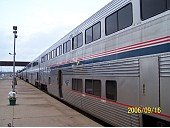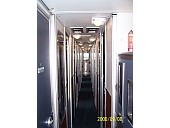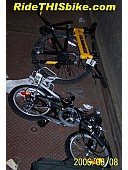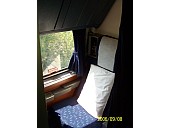 Recently, I returned from several bike trips far from home. Rather than take the car or plane, I got to the trail by train. The journeys were far more enjoyable than flying or driving and I will be traveling by train again. When I do, I'll take the following tips to heart to make the trip even more enjoyable.
Recently, I returned from several bike trips far from home. Rather than take the car or plane, I got to the trail by train. The journeys were far more enjoyable than flying or driving and I will be traveling by train again. When I do, I'll take the following tips to heart to make the trip even more enjoyable.10 Tips For Traveling By Train With A Bicycle
1. Make your reservation by phone.
A bike trip is a special occasion. When booking your rail tickets, get your trip off to a good start by speaking with a reservations agent so you can be alerted to any potential problems that the agent may foresee.
 2. Confirm that your points of arrival/departure are designated baggage stops.
2. Confirm that your points of arrival/departure are designated baggage stops.For stops at some small towns, the train does not stay long enough to accept or offload checked baggage. When making your reservations, find out now if bags can be checked through to your station so you won't have a rude surprise later.
3. Look over your tickets at least a week before you go.
The only way to confirm that your booking is completely in order is to see your tickets. I booked my trips a month in advance but opted to have the tickets waiting for me at the station's ticket counter on the day of departure. Bad move; I almost missed my train - TWICE. Check your tickets & confirm that all is in order.
4. Pack your bike carefully.
I used an Airliner case for transporting my full size Montague MX folding mountain bike. It's pretty tough but one of the latches came open during transit. Gladly, I had carefully tied everything down inside the case. Small bits that were removed from the bike so it would fit in the case (headset, wheel skewers, tools) had been stowed in a zip lock bag in my carry on so I lost nothing. Had the other latch come open, it could have been a disaster. Next time, I plan to wind duct tape around the case just to be safe.
5. Weigh your checked bags before you leave home.
Amtrak strictly adheres to a max weight per bag of 50 lbs. If the bag weighs more, they won't take it. NOTE: My experience was that bicycles were accepted provided I let the handler know in advance that it was a bike.
6. Before you leave for the train station, call Amtrak to confirm your train is on time.
For some of Amtrak's routes (Crescent, Sunset Limited & others), problems beyond Amtrak's control can cause delays of several hours. Rather than wait unnecessarily, call the train station first to see if they have been told of delays for your train. Even if you still have to wait awhile, at least you did your best.
 7. Get to the train station an hour before departure.
7. Get to the train station an hour before departure.There were times when unforeseen proplems almost caused me to either miss a train or miss the checked baggage cut off time (30 minutes before departure). Do yourself a favor; get to the station with an hour to spare. (Photo: Looking down the hallway in my sleeper car.)
8. Expect a minimal handling fee for bicycles.
The handling charge for checking a bike is $5 (far less than the ridiculous fees charged by the airlines). If you have a folding bike, you may avoid a handling fee completely. Twice, handlers said they'd have to charge me because the case containing my full size, folding mountain bike weighed over 50 lbs; however, when I told them it was a bike, they let me slide (your results may differ).
 9. Carry aboard your bike that folds at your own risk.
9. Carry aboard your bike that folds at your own risk.While Amtrak literature says you can carry on your bike that folds, the decision is up to the train's conductor. If the train is full, you run the risk that the conductor will not let you bring the bike aboard due to limited space for carry on's. This is less of a problem if you have your own compartment on the train but, believe me, you really don't want to be lugging a huge suitcase down the hall of a sleeper, let alone up the tight steps of a Superliner. And if you did, that big case will be sitting in your face the entire journey... (Photo: My bikes in the baggage car b/c there was no room to carry them on.)
 10. If it's in your budget, get a sleeper compartment.
10. If it's in your budget, get a sleeper compartment.If you're on the train several hours & can afford the splurge, opt for a sleeper even if you're traveling during the day. For privacy, sleeper cars are typically placed away from coach, minimizing foot traffic past your compartment (for quiet, ask for the sleeper car that's furthest from the engine so you don't hear the horn blow at street crossings). Meal service in the diner is included in the surcharge for your compartment and beverages in your car (bottled water, juice & coffee) are free. More importantly though, you'll receive better service because sleepers are considered 1st class. Thus, if you're traveling with a bike, you're likely to find the staff to be more obliging to your special needs than if you were in coach. (Photo: My sleeper compartment. Seats face one another & fold down into a bed that's surprisingly comfortable.)
Links:
- Bring Your Bicycle Onboard Amtrak
- Amtrak's Baggage Policy and Information
No comments:
Post a Comment